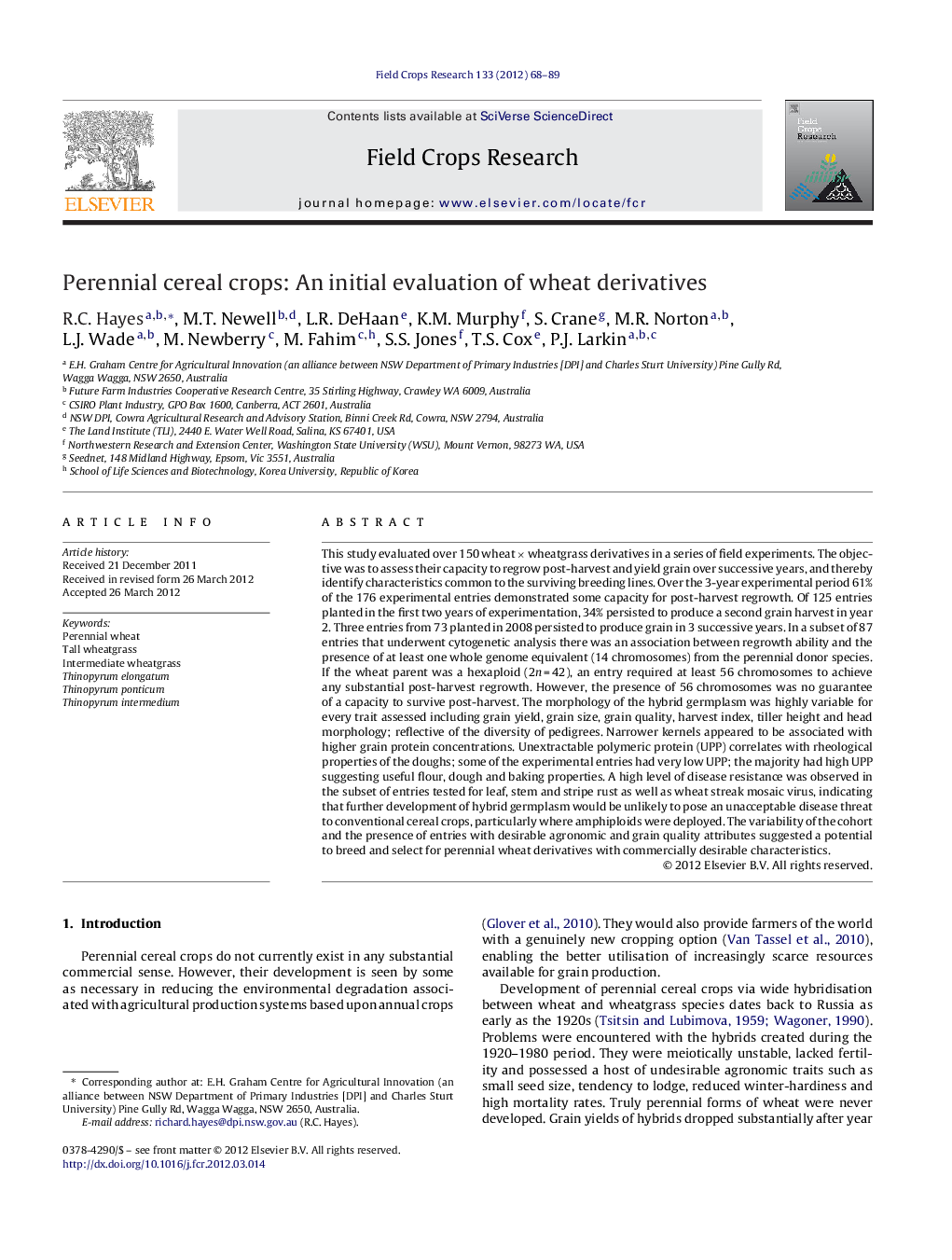| کد مقاله | کد نشریه | سال انتشار | مقاله انگلیسی | نسخه تمام متن |
|---|---|---|---|---|
| 4510476 | 1624730 | 2012 | 22 صفحه PDF | دانلود رایگان |

This study evaluated over 150 wheat × wheatgrass derivatives in a series of field experiments. The objective was to assess their capacity to regrow post-harvest and yield grain over successive years, and thereby identify characteristics common to the surviving breeding lines. Over the 3-year experimental period 61% of the 176 experimental entries demonstrated some capacity for post-harvest regrowth. Of 125 entries planted in the first two years of experimentation, 34% persisted to produce a second grain harvest in year 2. Three entries from 73 planted in 2008 persisted to produce grain in 3 successive years. In a subset of 87 entries that underwent cytogenetic analysis there was an association between regrowth ability and the presence of at least one whole genome equivalent (14 chromosomes) from the perennial donor species. If the wheat parent was a hexaploid (2n = 42), an entry required at least 56 chromosomes to achieve any substantial post-harvest regrowth. However, the presence of 56 chromosomes was no guarantee of a capacity to survive post-harvest. The morphology of the hybrid germplasm was highly variable for every trait assessed including grain yield, grain size, grain quality, harvest index, tiller height and head morphology; reflective of the diversity of pedigrees. Narrower kernels appeared to be associated with higher grain protein concentrations. Unextractable polymeric protein (UPP) correlates with rheological properties of the doughs; some of the experimental entries had very low UPP; the majority had high UPP suggesting useful flour, dough and baking properties. A high level of disease resistance was observed in the subset of entries tested for leaf, stem and stripe rust as well as wheat streak mosaic virus, indicating that further development of hybrid germplasm would be unlikely to pose an unacceptable disease threat to conventional cereal crops, particularly where amphiploids were deployed. The variability of the cohort and the presence of entries with desirable agronomic and grain quality attributes suggested a potential to breed and select for perennial wheat derivatives with commercially desirable characteristics.
► This is the first study in the western world to quantify the perenniality of wheat × wheatgrass hybrids under field conditions. Over 150 hybrid lines were tested and 61% of these demonstrated some capacity to regrow post-harvest. The strength of regrowth of the hybrid lines was inferior to that of the perennial grass controls, mountain rye and tall wheatgrass, suggesting more work is required to further enhance the survivability of this material. However, apparent mortality of individuals within lines which reduced regrowth scores in this study suggests a capacity to select within lines for an enhanced capacity to perenniate.
► Grain yield, grain quality characteristics, crop morphology and disease resistance are each quantified for a subset of lines tested, and compared to conventional wheat controls in order to benchmark current progress in developing the world's first commercial perennial cereal crop. Though no lines were commercially deployable in their current form, the relatively desirable characteristics observed and the large variability observed in the cohort of material suggests a great potential to further refine these characteristics over time in the pursuit of a commercially deployable crop.
► Cytogenetic analysis and molecular markers were used on a subset of lines to help understand common characteristics of the lines demonstrating a capacity to perenniate. Our results infer that the presence of one whole extra genome equivalent (14 chromosomes) from the perennial donor parent was necessary for the progeny to regrow post-harvest. This finding has important implications for perennial cereal breeding programs which seek to understand the genetic composition of perennial cereal crops.
► This manuscript reports critical benchmarking data quantifying current progress in the development of perennial cereal crops derived from wheat, and presents insightful discussion about the future prospects and directions of continued research in this emerging field.
Journal: Field Crops Research - Volume 133, 11 July 2012, Pages 68–89